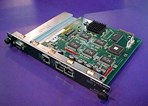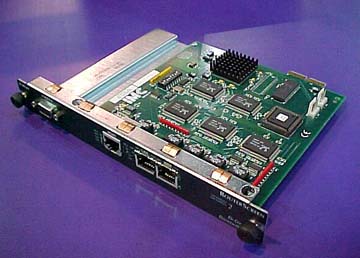IMC Networks Unveils Routerscreen to Improve Router Performance

By: John Spofford, Managing Editor, Premises Networks Online
Offering easy-to-install Layer-3 switching capability to any network, <%=company%> (Foothill Ranch, CA) announced this week at Networld + Interop (booth #541) the availability of its RouterScreen, a Internet infrastructure device designed to maximize router efficiency and improve Internet access performance. By discarding LAN traffic not destined for the Internet, devices such as routers and firewalls are shielded from unnecessary traffic, thus preventing traffic overload.
"We use packet filtering to make sure the only frames that reach the router are frames destined for the Internet. We get rid of the junk first," explained Brendan Mullooly, IMC manager of European operations.
In many enterprises, employees trying to access the Internet are frequently plagued with slowdowns and disconnects caused by traffic congestion between the LAN and the Internet router. This router can devote up to 95% of its time handling non-Internet traffic, according to studies performed on behalf of IMC Networks.
"The simple fact is routers have enough work to do. Add in applications such as NAT [network address translation] and many mid-range routers are at the edge of hardware capability," Mullooly said.

Thus far the only solutions available to a network manger are expensive ones: acquiring faster lines, upgrading to a more powerful router, implementing flow control and traffic shaping, or investing in intelligent Layer-3 switches that examine LAN traffic and decide which way it needs to go. By contrast, RouterScreen is simply connected on one port to the LAN and on its other port to the Internet router. Every piece of traffic received on the LAN port is inspected and passed on only if it is Internet-bound.
Speed increases, as determined by beta tests of the product, are significant. IMC Networks indicated that Internet access can be improved as much as 30%.
IMC Networks is targeting RouterScreen to Internet service providers for use at the core backbone where the product works at Layer 3 as a sort of throttle for the ISP. Perhaps a larger market, according to Jukka Rissanen, IMC product marketing manager, is the network edge.
"We are targeting medium-sized companies, smaller networks up to 50 or 60 seats, as well as the SOHO [small-office/home-office] market," he said.
The latter market consists of systems administrators, or corporate information systems chiefs—professionals that have a pressing need to improve the performance of legacy routers at a minimal cost.
Screening process in detail
- First, RouterScreen examines Layer-3 LAN traffic types and address information to decide what is forwarded to the Internet, providing users with advanced Layer-3 functionality at a low price.
- The unit offers a variety of packet filtering modes that can be set depending on the installation. RouterScreen inspects local traffic based on protocol type and/or IP address; local broadcast and multicast data may be forwarded or blocked as required. Flexible packet filtering modes allow network administrators to filter traffic according to the requirements of their network.
- RouterScreen eliminates congestion on the router with bi-directional bandwidth control on both the LAN and the router (WAN) ports. The IMC Networks product controls bandwidth and adapts the speed of the LAN to the WAN through data buffering, spacing frames evenly and providing additional buffer memory.
- Finally, the product is easy to configure via iView, IMC Networks' GUI that is based on the SNMP management.
Available immediately, the RouterScreen carries a $999 price tag. A modular version of RouterScreen that can owners of IMC Networks' PowerChassis/101 can use costs $899. For more information, call 800-624-1070 or visit the web site at (http://www.routerscreen.com).
